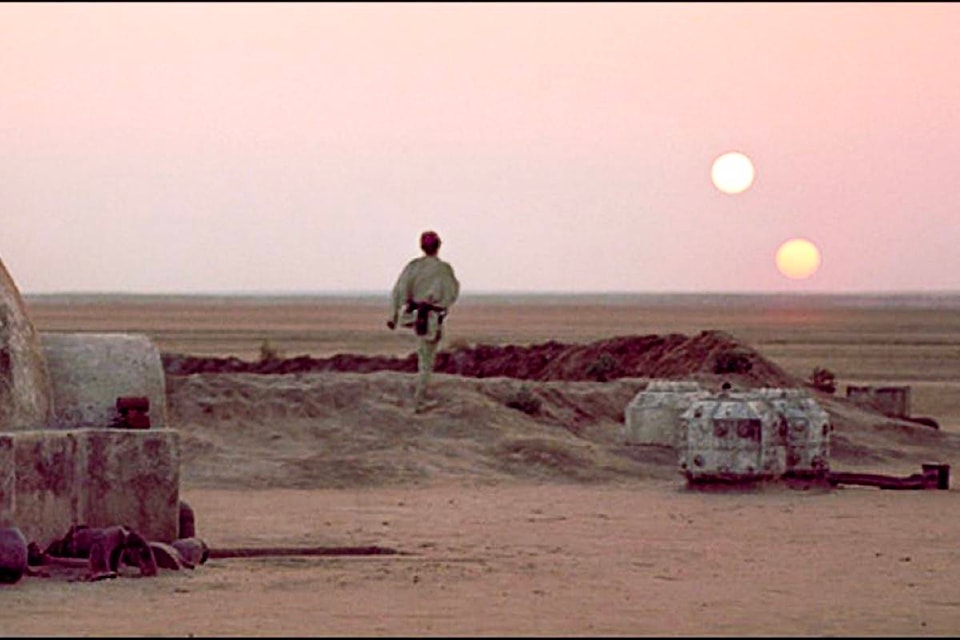There is a scene in the first Star Wars movie where, on the desert planet Tatooine, Luke Skywalker watches the setting of twin suns. Was this scene realistic? Are there double stars, can they have planets, and would those planets be inhabitable? How do double stars form?
The is no question that double stars exist. A good number of stars in our galaxy and presumably other galaxies are orbiting one or more other stars. For example, look at the second star in from the end of the handle of the Big Dipper. You will see this star, named Mizar, who has a companion called Alcor. Binoculars will show it well. My favourite double star is Albireo, in the constellation of Cygnus, The Swan. A small telescope shows an orange star with a brilliant blue partner.
Countless manmade satellites are orbiting the Earth, and at least one natural one, the moon. If we try orbiting satellites in higher and higher orbits, the Earth’s gravitational attraction gets weaker and weaker, until it is not strong enough to hang onto a body, and it wanders off to orbit the sun. We can call this the Earth’s “sphere of influence.” Even giant planets like Jupiter have spheres of influence, although, with the large mass of the planet and the weaker solar gravity at that distance, that sphere is bigger.
The solar system formed from the collapse of a cloud of gas and dust. The cloud formed a rotating disc and the central part formed the biggest lump, which became the sun. Other lumps formed the planets, but the sun’s grip on the matter in the disc kept their spheres of influence comparatively small, which slowed their growth and made sure the sun had no strong competition when it came to pulling in cloud material. The result was the solar system we have today, with one star surrounded by a retinue of planets. However, if a bigger cloud collapses, forming a bigger disc, things can be different. In the outer parts of the disc, any growing lump of material forming in the disc would have much poorer gravitational control over distant parts of the disc, so other lumps forming there would have larger spheres of influence and greater ability to grow to larger masses. Since whether a lump becomes a planet or a star depends simply on the amount of material in the lump, the lumps of material in larger discs have a bigger chance of becoming stars, so the system might contain two, three or more stars. Although more material has been grabbed to make stars, there is a chance that some was left over to make planets. However, their orbits will be rather complicated and involve enormous changes in temperature, probably not the best places for life to form or for us to colonize.
If a really big cloud collapses, it will form multiple discs, each of which will form one or more stars. The result is a “star cluster,” which may contain thousands of members. The Pleiades is a star cluster. In our studies of stars, clusters are very useful since they contain stars of various masses all born at about the same time and more or less the same distance from us.
The Atacama Large Millimetre Array radio telescope (ALMA), in Chile, is designed to observe and image radio waves with wavelengths of millimetres. These very short wavelengths enable us to look at what is going on inside clouds in the process of forming stars. Astronomers have very recently used the ALMA to produce an image of a collapsing cloud in the process of forming a double star. Rather than just a disc with a new star in the middle, the main features are great streamers spiralling out from the pair of newborn stars. Any planets forming with them are going to have extreme conditions: far worse than Tatooine.
Jupiter and Saturn lie low in the southwest after dark. The moon reaches its first quarter on Nov. 4. Mars lies very low in the east before dawn.
Ken Tapping is an astronomer with the Dominion Radio Astrophysical Observatory near Penticton. Email: ken.tapping@nrc-cnrc.gc.ca
